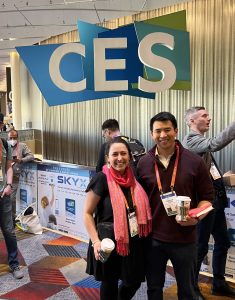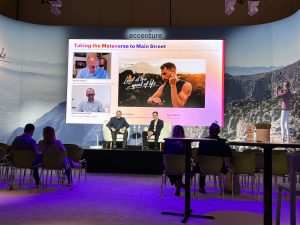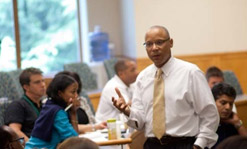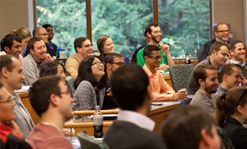CDS at CES: Macro takeaways from the Consumer Electronics Show
January 18th, 2023

Earlier this month, CDS Executive Director, Patrick Wheeler, traveled to Las Vegas with CDS MBA fellows, Carly Wolberg T’23 and Andrew Chen T’23, to attend the Consumer Electronics Show (CES). For the uninitiated, “CES is the most influential tech event in the world — the proving ground for breakthrough technologies and global innovators.” The conference is run by the Consumer Technology Association (CTA), and is diverse across a number of industries, from agricultural and automotive, to personal tech and digital health.
At Tuck and in the CDS, we believe deeply in experiential learning and connecting learning in the classroom to real world application. Our trip to CES is a great example of how we bring these beliefs to life for students.
To that end, we’d like to share our major takeaways from CES 2023:
There was a significant focus on technology solutions that solve for labor shortages in the US market. Technologies ranging from automated rehabilitation devices to autonomous lawn mowers all have one thing in common – they’re designed to solve for persistent labor shortages in the US economy. While not all of these technologies truly add value, collectively they all point to the impact of labor shortages and suggest technologists are trying to solve for the downstream impact of labor issues.
There was a proliferation of technologies that embed voice assistants into existing solutions, without adding significant value. Recent news points to stagnation in the voice assistant space, with Amazon laying off significant portions of its Alexa workforce. Despite this reality, there were a large number of Alexa integration, including automobiles and even a demonstration by Amazon of building an integration of Alexa into Apple CarPlay, which is a curious use case that doesn’t seem to have a real problem it’s trying to solve. I expect the voice assistant space to decline further until true, high-value use cases emerge. Amazon introduced many new products in addition to voice assistant work, including many products in its Ring line of home security products. For a complete overview of Amazon’s CES product announcements and showcases, visit their CES website.
 The healthcare space has gone all in on tech, with a heavy emphasis on AI- and IoT-focused solutions. One of the more fascinating areas of CES this year was the health space. As a space with tremendous growth potential, measurable impact, and a serious labor shortage, the digital health/health tech space is primed for investment, innovation, and opportunity. Some of the interesting technologies on display included several urinalysis devices connected to your toilet via a smart sensor (Withings, Olive, and Vivoo all showcased their products), a robotic orthopedic rehabilitation solution from H Robotics, and a number of AI-enabled devices for all sorts of health challenges. One such device from iMediSync analyzes brain waves for numerous illnesses and then uses LED light therapy as a form of treatment.
The healthcare space has gone all in on tech, with a heavy emphasis on AI- and IoT-focused solutions. One of the more fascinating areas of CES this year was the health space. As a space with tremendous growth potential, measurable impact, and a serious labor shortage, the digital health/health tech space is primed for investment, innovation, and opportunity. Some of the interesting technologies on display included several urinalysis devices connected to your toilet via a smart sensor (Withings, Olive, and Vivoo all showcased their products), a robotic orthopedic rehabilitation solution from H Robotics, and a number of AI-enabled devices for all sorts of health challenges. One such device from iMediSync analyzes brain waves for numerous illnesses and then uses LED light therapy as a form of treatment.
For example, the device can help customers with Parkinson’s disease, anxiety, and other conditions, with a promise of more on the way in the future. With these innovations, the question still remains around how/if providers can use or access the patients’ data from these products to realize the improved health outcomes that they’re promising to consumers, but there is considerable investment being made into the space in the hopes that therapies will get better over time and privacy concerns will be solved in the future.
A significant, and needed, shift from technology sector-driven transformation to industry-driven transformation is underway. Some of the most exciting technology solutions at CES came from some of the oldest companies at the conference. John Deere and Caterpillar both showcased cutting edge technologies, with both seeking to increase efficiency, lower costs, drive sustainable solutions, and also solve for labor shortages.
Deere introduced its ExactShot technology, which allows farmers to reduce the amount of starter fertilizer needed during planting by more than 60%, as well as a new electric excavator, powered by a Kreisel battery, which includes innovative immersion-cooled battery technology. According to Deere, “The batteries are modular, reducing the cost of ownership, and use a charging infrastructure that costs about 50% less than typical electric-vehicle (EV) fast chargers.” Learn more about John Deere’s CES technologies on its website, and watch Deere Chairman and CEO John May deliver the CES 2023 keynote address on YouTube.
Like Deere, Caterpillar is an older company that hasn’t let its age limit its deployment of real technological solutions. The company is a major player in the mining space, and its trucks and heavy equipment (like Deere) are some of the more active players in the autonomous vehicle space. According to the company, Caterpillar now operates more than 550 fully autonomous dump trucks around the world, many of which operate 24/7, all without any downtime of the autonomy systems. At CES, the company showcased it’s autonomous fleet including an impressive large 770 dump truck and a remotely-operated bulldozer cockpit at the company’s booth. The remote bulldozer connected to a live bulldozer in Tucson, Arizona, and allowed visitors to drive the remote equipment from the floor of CES. Learn more about Cat’s CES showcase on their website.
There was an abundance of cool metaverse-focused tech, but much of it fell short on value. Much of the metaverse tech on the showcase floor was bold and exciting, but it was a challenge to see the applicability of the most audacious tech. Across the vendor floor(s) we witnessed multiple hologram demos, a plethora of VR headsets, and an overwhelming number of companies claiming to be the future of the metaverse. As is so often the case, the best use cases for many new technologies do not come from the B2C space, but the B2B space. I saw little to dissuade me from believing the same to be true with metaverse.
One example of a company in the B2B metaverse/XR space is RealWear, an assisted reality company that builds hands-free headsets so that users can access information, including augmented reality images, when completing complicated tasks. The company primarily serves industrial customers, with a focus on industries like oil & gas, manufacturing, automotive, etc. RealWear’s Chief Product officer, Rama Oruganti T’09, is a CDS Fellow Alumnus and was on hand at CES as well.
Further, in a private session hosted by Accenture on the metaverse and its applications in healthcare, a more nuanced point of view emerged worth noting. In that session, Teladoc Chief Innovation Officer Claus Jensen clearly explained how the metaverse is really just an expansion of the endpoints of interacting with patients. That explanation makes a lot of sense and removes barriers tied to specific platforms and technologies when developing a metaverse strategy, theoretically avoiding firms building walled gardens that prevent interoperability at the expense of patients and providers. That session was moderated by Tuck alumnus Kevin Collins T’99 who is managing director at Accenture in their software and platforms business. Kevin spent a great deal of time with the entire CDS group at CES, both explaining what Accenture is doing and also helping us think through the trends and use cases for a wide range of products showcased at CES. A huge thank you to Kevin for being so helpful and supportive of the center, Tuck students, and our trip to CES!
For more on metaverse tech at CES, visit the CES 2023 website.

Autonomous vehicles open up new form factors, including vehicles that have the ability to greatly improve accessibility
Real changes to automotive form factors (smaller, easier, etc.) will enable improved accessibility. As the autonomous vehicle segment matures, new form factors are starting to emerge that reject a driver-centric approach in favor of use case-driven designs. Several companies at CES showcased vehicle form factors that prioritized accessibility and wheelchair-bound passengers. The existing market for accessible transportation is still very driver-centric, and the changes demonstrated at CES were a welcomed change with the potential to significantly improve the lives of those requiring wheelchairs.









